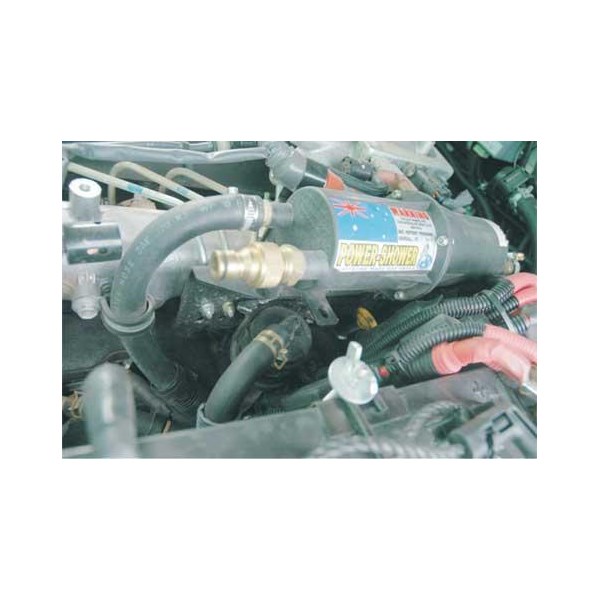Lancruiser 100 series water flow
Submitted: Wednesday, Oct 03, 2012 at 11:45
ThreadID:
98366
Views:
3289
Replies:
3
FollowUps:
6
This Thread has been Archived
yerrk
Can anyone tell me the direction of
water in a 2004 100 series as I am installing a Shower heat exchange unit Cheers Kerry
Reply By: pop2jocem - Wednesday, Oct 03, 2012 at 13:49
Wednesday, Oct 03, 2012 at 13:49
Not sure with the petrol engines but I don't see why they should be any different to a diesel and I am pretty sure they flow from the top hose of the engine into the radiator and out the bottom back into the engine. If you are installing a heat exchanger to heat
water for your shower I don't see why it would make much difference which way the engine coolant flows.
AnswerID:
496095
Follow Up By: Member - Rosco from way back - Wednesday, Oct 03, 2012 at 14:33
Wednesday, Oct 03, 2012 at 14:33
Not so sure about that.
Given the hot air/
water rises (or more correctly is forced up by the more dense cooler air/
water), it would then make sense for the hot coolant to enter via the bottom hose and then cool as it rises. Going the other way means the pump is working against the natural flow.
I wouldn't bet my house on it though.
FollowupID:
771698
Follow Up By: pop2jocem - Wednesday, Oct 03, 2012 at 14:43
Wednesday, Oct 03, 2012 at 14:43
I wouldn't argue which way it flows in the Landcruiser as not 100% sure but I am pretty sure with the very old thermo-syphon systems (before they discovered
water pumps...lol) they took advantage of the fact that as the
water cooled and sank in the radiator the
water in the engine rose as it heated. When they started fitting
water pumps it assisted with the natural flow.
FollowupID:
771699
Follow Up By: Ross M - Wednesday, Oct 03, 2012 at 19:26
Wednesday, Oct 03, 2012 at 19:26
Rosco
It really makes sense for the hot to enter the TOP as it will be cooled by the heat exchanger and be cooler at the bottom before return to the engine cooling system. It is pumped around and the natural flow of thermosyphoning isn't really a factor here.
So I believe it to be best, frack to bunt, to what you propose.
FollowupID:
771723
Follow Up By: Member - Rosco from way back - Wednesday, Oct 03, 2012 at 20:27
Wednesday, Oct 03, 2012 at 20:27
You're probably right mate.
Just as
well I didn't bet the house ..;o)
FollowupID:
771728
Follow Up By: pop2jocem - Wednesday, Oct 03, 2012 at 23:14
Wednesday, Oct 03, 2012 at 23:14
I sometimes wonder if people actually read a post before answering???
FollowupID:
771739
Follow Up By: yerrk - Thursday, Oct 04, 2012 at 09:39
Thursday, Oct 04, 2012 at 09:39
Thanks ,the direction i was after was from motor to heater and return by using the return you can control the heat with the heater control's
FollowupID:
771748
Reply By: Bob Y. - Qld - Wednesday, Oct 03, 2012 at 14:54
Wednesday, Oct 03, 2012 at 14:54
Kerry,
Just went and checked my '02 L/C td ute, and the heater hose comes from the passenger side, at the rear of the block, up to the
water metering valve, then disappears via a short hose, into the fire wall.
Would suggest you fit your heat exchange unit between the block and w/m valve.
Water will flow through the heat exchanger, towards the valve, and into the heater, and back to the engine(on driver's side) when you adjust the heat control, in the cab.
The tricky part is finding an ideal position for the H/E, and having the right hoses/bends for the fit.

On 1HZ engine

Bend & Fittings

Different H/Exchange Unit.
The above are some photos I scored off the net, to act as a reference for fitting. The other thing to remember is(and I got this bit of advice off this
forum) to have the flow of your shower
water in the opposite direction to the engine coolant flow.
Bob.
AnswerID:
496097
Reply By: yerrk - Thursday, Oct 04, 2012 at 09:15
Thursday, Oct 04, 2012 at 09:15
Thanks all for the info should be able to work it out now cheers all and happy traveling
AnswerID:
496128